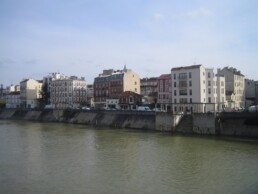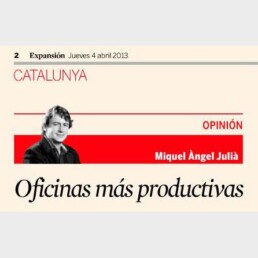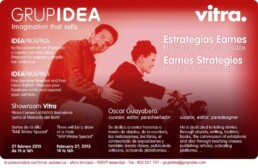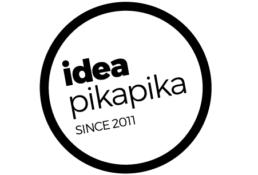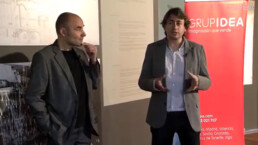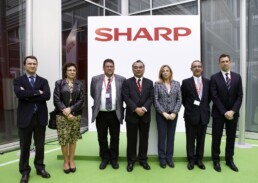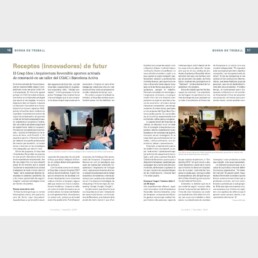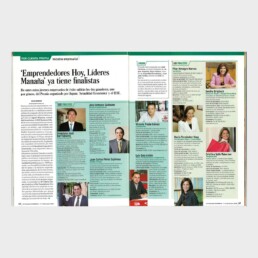GRUP IDEA opens a new subsidiary in France.
After last year’s opening of the subsidiary in Mexico, we have created another subsidiary in Alfortville, next to Paris, in order to address the needs of our clients in France.
Internationalization is part of the strategic plan for growth of our company to export our work and help our customers sell in an imaginative way through envisioning the spaces and the design, thanks to processes of open innovation.
Expansión - More productive office
Article by Miquel Angel Julia, design director Grup Idea, on how to deal with office renovation projects to bring about change in organizational culture.
Idea PikaPika X "Design as Communication: Eames Strategies by Oscar Guayabero".
On February 27th, 2013, we kicked off the third season of IDEAPIKAPIKA with Oscar Guayabero in VITRA´s showroom. Below are the key ideas of his speech.
Oscar Guyabero considers that a Design and / or Architecture Study in order to be good should work on five main areas: Creation, production, sale, archiving and research. The creation and production phases are well developed, but instead we are very bad sellers. But as Oscar says, "If there are no customers, there is no design".
The disciplines of research and archive, applied both on the finished product and on the work processes, are poorly developed. Oscar Guayabero decided to dedicate himself to both. He is a designer, but he describes himself as "para-designer". Actually what he does is tell stories and he does it through objects, writing, facilities, books, curating exhibitions and also through teaching, publishing articles, enabling platforms, and more.
The idea behind Oscar Guayabero’s speech, was to investigate the strategies of Charles and Ray Eames, understanding DESIGN as COMMUNICATION. To achieve this, he focused on three concepts: Circus, Film and War Rooms.
Both Eames where interested in the CIRCUS as a discipline and for the multiplicity of actions that occur in it. In the three-ring circus the observer is unable to see all of the action at once, but he is able to keep some parts of it and most importantly,he can create new connections between them.
When they asked Charles Eames "What is design?" He replied with disjointed sentences but with a global sense like: "Design is a plan to place elements in the best way to achieve a particular purpose. Eventually everything connects: people, ideas, objects; admitting the influence of those who came before. The quality of the connections is the key to the quality of the resulting design. "
One of the foundations of their work was to understand everything: objects, places, movies, etc.. as a communication project following a specific strategy: "When you overload the user with information, you expand the menú options and new connections are established."
The Eames were interested in the large capacity of narrative and communication of the CINEMA, The Eames softened technology transforming it into a domestic and familiar show.
The WAR ROOMS or the SITUATIONS ROOMS, for the Eames, have to do with CONTROL. We're talking about the 50s, the Cold War; these are rooms with large SIMULTANEITY of data so politicians can make decisions in real time. For them, the multiplicity of details generates a whole.
"Now we know that we only lose control of what we create if we refuse to take responsibility for the direction and discipline of the use of our creations" (Charles Eames).
The Eames created environments of multiple stimuli and high-sensory intensity so the user would not focus on a single concept and thus challenge him to assume new ideas and most importantly, connect them with each other. They were interested in both the concepts themselves, as to relate them to others who at first had no connection.
They understood noise in positive, as a distortion factor of the message. Simultaneous messages lower the guard to the most rational prejudices of the user and it is then that he allows the entry of new ideas.
For the Eames the DESIGN was not just a profession, but a way of life. For the Eames,design was to give. The work of the Eames, did not end when a building was built; the documentation was part of the project.
As Oscar says, "The best project of the Eames are the Eames."
Oscar Guayabero - GRUPIDEA PIKA PIKA - 27/03/2013
Idea PikaPika VIII "Design Management. From design thinking to business" by Tomás Cerón.
Tomás Cerón architect, Design Manager. At Col·legi oficial d’arquitectes de Catalunya, COAC
https://vimeo.com/223104769
The anecdotes of the architect Antoni Gaudí and his working method
On 21 June 2012, the presentation of the Espai Gaudí "The workshop of a genius or a madman" was held at the Diocesan Museum of Barcelona. Miquel Àngel Julià Hierro, director of design and strategy at Grup Idea, made the presentation of the exhibition in the company of the historian and curator of the space Marià Marín y Torné, who years later would be the co-founder of The Gaudí Research Institute (TGRI).
Grup Idea took part in the presentation of the exhibition and held an edition of Idea Pika Pika, a networking event in the same room, after Marín's talk. In his first intervention, the historian spoke about the figure of Antoni Gaudí, his more business-oriented point of view based on a series of anecdotes from throughout his life. His work method, interdisciplinary, innovative and focused on the search for detail, inspires the work of Grup Idea day after day. In this article we bring together point by point the anecdotes of Gaudí the entrepreneur as presented by Marià Marín in his talk:
- Inspiration in nature and a great ambition. Nature has created forms that are functional and therefore optimal. Gaudí was inspired by the forms of nature in his architecture, but he is surprised that no one had ever put it into practice before. "My ideas are indisputably logical, the only thing that makes me doubt is that they have not been applied before," he says. Still, he tells himself that "just because something has never been done before, doesn't mean we don't have to try it".
- The R&D driver: research and development. In order to put new constructive and architectural forms into practice, Gaudí brought an engineer into his studio and built the famous polyfunicular model, which took him 10 years to complete. To achieve the desired trichromy in the windows, he looked for an optician at the university and a chemist at the industrial school. The industrial school was the first materials testing laboratory in Europe. He works with a hypothesis and puts it into practice.
- The importance of the interdisciplinary team and active listening. Today's computer scientists working on the calculations of the structure with supercomputers do not understand how Gaudí made the calculations with the tools he had at the time. How did he do it? Through his team: a 14-15 year old boy, a bricklayer and an engineer. The engineer will be useful to make the calculations, the bricklayer has experience in construction and the young boy will be an effective apprentice but, above all, he will ask the why of everything that the others will not dare to ask.
- Collaborators, not disciples. For the Parc Güell works, Gaudí surrounded himself with collaborators, among them Josep Maria Jujol. Jujol was responsible for much of the decoration using the trencadís technique, as in the case of the bench in the Plaça de la Natura. Some of the benches in the Colonia Güell are also signed by the craftsmen who made them.
- Aesthetics and functionality. What idea do I have, what is art, and beauty? The radiance of truth. And truth is God. And how do I reflect this? Very easy: if the architecture I make is not rational and useful, as well as beautiful, I have made a mistake. In Gaudí's words: "what is the use of all this if I do not put my heart before the technique".
- Sustainability, the search for difference. He applies the idea of functionality to the design and construction of his works. He is sustainable and has a strong inclination towards recycling. In his works he relies on his collaborators, makes the most of the light and does not generate reverberation in any space: 'Originality serves as a return to the origin', he says.
You can watch the talk by Marià Marin i Torné, historian and curator of "Gaudi's Study" at the Diocesan Museum of Barcelona in the following video (in Catalan):
GRUP IDEA designed the new SHARP Spain corporate headquarters SHARP Europe in the WTC of Cornellà
On May 17th, 2012, SHARP Spain opened the Centre of Excellence for the consumer electronics group in Europe.
The event was chaired by Mr. Paul Molyneux, CEO of Sharp Europe. Mr. Ventura Pobre, CEO of Sharp Spain, presented the modern facilities to the Vice President of the Government of the Generalitat de Catalunya, Joana Ortega, the Consul General of Japan in Barcelona, ??Hidehiro Tsubaki, and the Deputy Mayor of Cornellà de Llobregat, Antonio Martínez and other authorities.
SHARP Spain renews with new structure, new spaces behave. Therefore entrusted the design of their corporate spaces to IDEA GROUP, a company specializing in corporate architecture and design. “Sharp has been the inventor to society for almost a hundred years.” The project seeks to convey the story and the new brand image focused on the R&D, new technologies and design.
A multidisciplinary team of GRUP IDEA has designed, based on those responsible for SHARP, an office that foster synergies and teamwork.
GRUP IDEA at INDE magazine of COAC
GRUP IDEA and Arquitectura Reversible were invited by COAC to a conference in BCN ACTIVA, in Innovation class.
Actualidad económica
Finalist of the award´s second edition, organized by Jaguar Hispania, the magazine Actualidad Económica and IESE Business School.
Idea PikaPika VI “Paradigms that melt on retail” by Lluís Martínez-Ribes.
March 24, 2012, we began the itinerant IDEAPIKAPIKA on Arpa Design store in Barcelona Centre. On this occasion Lluís Martínez-Ribes spokes of the paradigms that melts at RETAIL.
We need to distance from routine to see if reality changes, and observe the environment. If we all walk towards the same direction, how will we know there is no other one? The formula to calculate the profit of a product like the difference between the final price and the indirect expenses is obsolete. According to “the new capitalist manifesto” by Umair Haque, the calculations must be done in the long term and measure the side-effects. The ending of the sustainable and continued sale and buy should create a relation that must be long and longlasting. It is about creating a compromise between brands and customers. The benefit comes from the customer, from their considerations. Humanism is gaining in importance. A good seller must wonder what their establishment contributes to the customer, being it either a store or a bank. Because of this, the co-creation with customers is fundamental. But listening to the customers is not enough. We have to interpret their comments in order to be ahead of their needs. If we do not proceed this way, we are only improving, but we are not innovating. The technical specifications of a product are not enough to sell more, we should make the customer fall in love. Between the 85% and the 95% of our decisions are taken by the limbic system (it means an emotional decison) , which has nothing to do with reasoning. Read more
